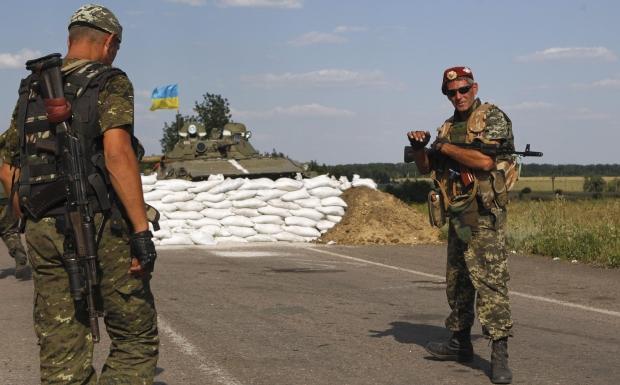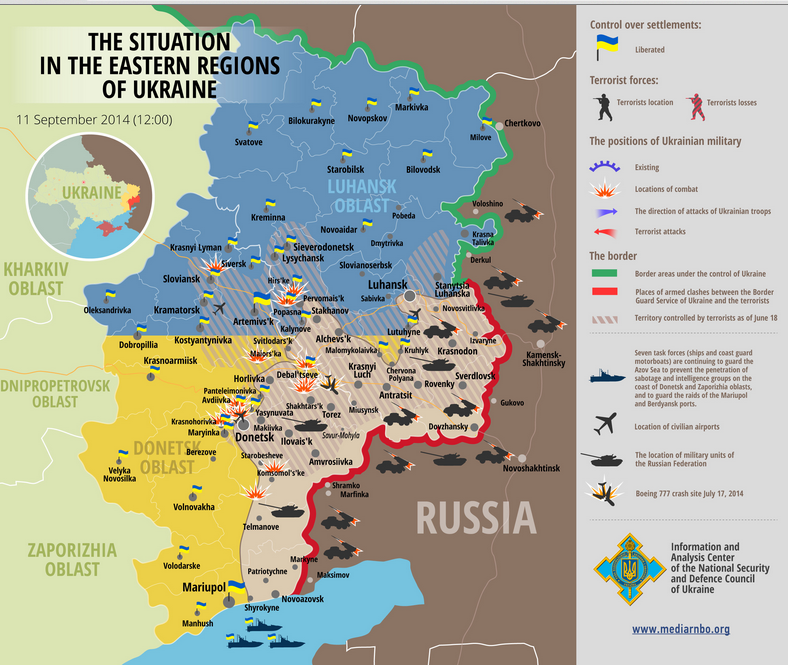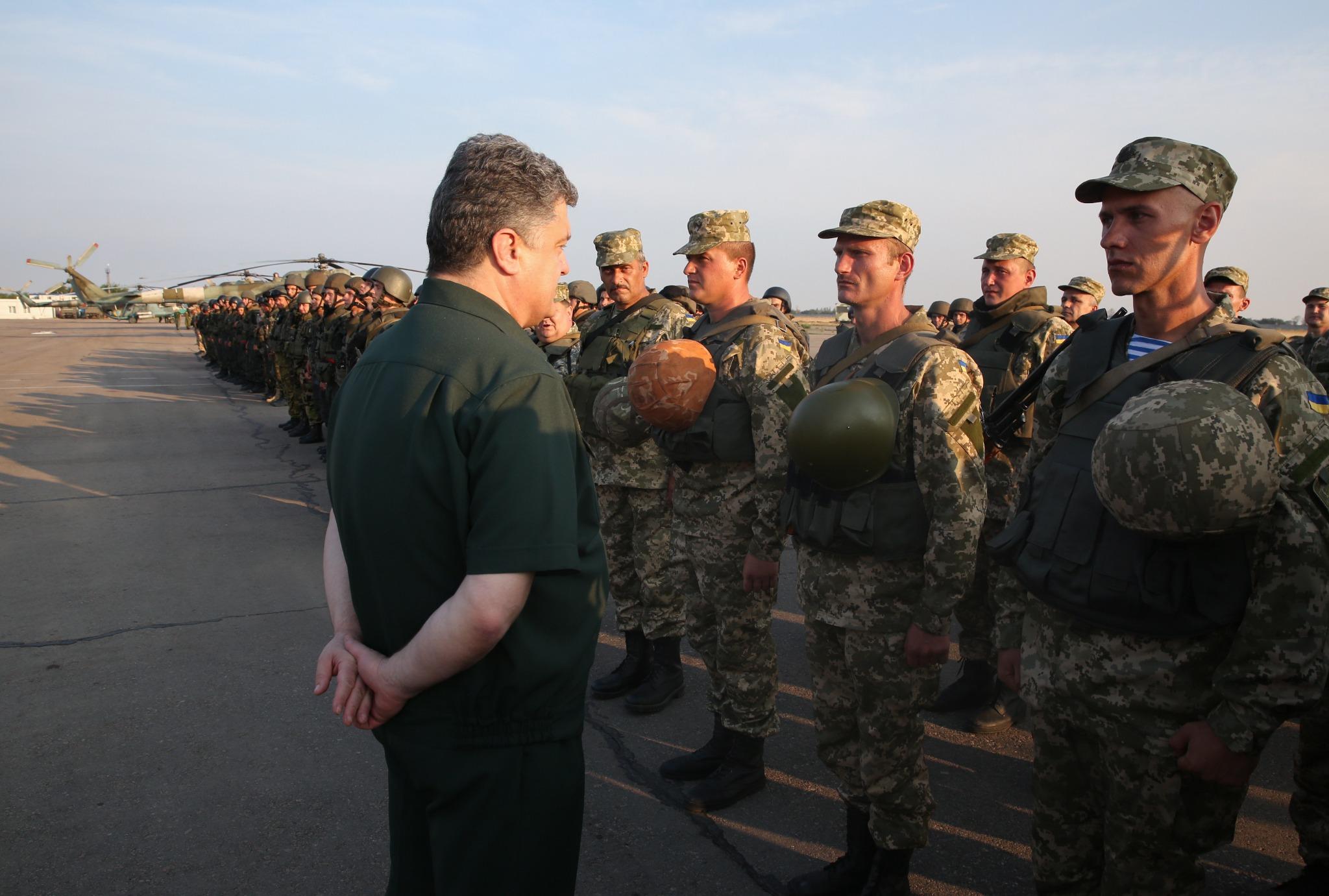by Ian Bateson
Ukrainian soldiers ride a tank on a road close to where pro-Russian rebels fired heavy artillery outside Mariupol on September 5.
When tanks and artillery entered the southern Donetsk Oblast from Russia on Aug. 27 it caught Ukrainian forces off guard, sending shockwaves through Ukraine’s leadership. Resistance quickly crumbled as the advancing forces took Novoazovsk and surrounding villages.
With reports that Russian regulars led the offensive not Russian-supported Ukrainian separatists or volunteers, Ukrainian Prime Minister Arseniy Yatsenyuk appeared in front of television cameras visibly shaken. “Russian terrorists we can handle, but not the Russian army,” he said before trailing off.
With the new offensive the optimism that existed in July, when Defence Minister Valeriy Heletey said Ukraine would hold a victory march in the Crimean city of Sevastopol, has evaporated. Doubt is growing among both the Ukrainian officials and military experts as to whether Ukraine could win this war.
Ukrainian President Petro Porosheknko announced intentions to reshuffle the military leadership, but any reshuffle will add to an already confusing situation where civilian and military bodies attempt to coordinate a war effort still referred to as an “Anti-Terrorist Operation” (ATO).
For now an uneasy ceasefire is in place, giving both sides an opportunity to regroup. But if and when massive fire restarts, whoever ends up heading the military effort after the reshuffle will not only have to deal with a situation where Ukrainian forces are on the defensive, but will be under pressure to retake lost territory, and demonstrate a clear strategy that has previously been absent from Ukrainian military operations.

Ukrainian soldiers standing on the checkpoint defending one of the approaches to Donetsk Airport. (Sept. 8)
The situation now
“I don’t see any tactics from the Ukrainian side. No tactics to fight the Russian invasion,” said Archil Tsintsadze, a retired Georgian colonel who fought in Abkhazia and former military advisor to the Georgian embassy in Kyiv.
As the armed conflict in Ukraine’s east has continued, Ukraine has come under increasing criticism for not having a clear strategy, and instead simply reacting to events as they happen.
After ending a unilateral ceasefire this summer, Ukrainian forces made rapid advances, taking territory back from Russian-supported separatists, but failed to deliver a coup de grace that could have defeated the separatists. Instead Ukrainian advances pushed separatists into the heavily populated regional centers of Donetsk and Luhansk, complicating fighting that has already seen a high number of civilian casualties.
Before the latest escalation of events on Aug. 27, Ukrainian authorities claimed several times to have successfully encircled separatist forces in Donetsk and Luhansk, only for it later to become clear that men and equipment were still freely able to get in and out of those areas. But the effort to contain separatists came to an end when a new front was opened in the southern Donetsk Oblast.
“Now it is more or less clear that after the maneuver by separatists or Russians near Mariupol the Ukrainian army doesn’t have the forces to encircle Donetsk and Luhansk anymore,” said independent Russian military expert Alexander Golts.
A map released by the Ukrainian Security Council on Sep. 11 seemed to confirm the new status quo, showing Luhansk, Donetsk, and Novoazovsk, along with a large chunk of surrounding territories, to be solidly connected by territory controlled by Russian-backed forces.

This change means that supply routes to both Donetsk and Luhansk remain open, allowing the separatists to continue receiving reinforcements in manpower and heavy weaponry.
This shift has put Ukraine on the defensive as it not only struggles to hold Mariupol, the second largest city in the southern Donetsk Region, but prepares for further escalations instigated by Russia that could bring fighting to other previously unaffected parts of Ukraine.
“We need to prepare Ukraine’s territory militarily just like Mariupol, creating fortifications and new units. That should be the norm not just for Mariupol, but also for other important cities either bordering Russia or near Crimea Kherson or Donbas. That includes Zaporizhia and Dnipropetrovsk,” said Ukrainian military expert Viacheslav Tseluikov.
Experts, however, point out that if it comes to a full on clash between Russian and Ukrainian forces, despite the superior size of Russia’s army if prepared Ukraine would still have certain advantages.
“Russia is a big country. Their problems don’t stop with Ukraine. They can’t take soldiers away from the Caucasus or the far east. Ukraine can use all of its forces against Russia and Russia can’t use all of its forces against Ukraine,” said Tseluikov.
So far, however, Ukrainian leaders have fallen short of describing hostilities in its east as an outright war and taking the precautions preparing for a war would normally entail.
The organization of the military campaign in the east also shows a failure to make that shift. Military operations in the east are currently coordinated by the Security Service of Ukraine (SBU), Ukraine’s successor to the KGB, rather than the Ministry of Defense.
“When fighting involves Russia regulars that isn’t an anti-terrorist operation but a war, and a war should be led by Ministry of Defense,” said Tseluikov.
It is a sentiment echoed by many in Ukraine’s military circles with a statement released in early September by former military officials and experts calling for a transfer of leadership from the SBU to the Ukrainian armed forces.
What it would take to reclaim Donetsk and Luhansk
If full hostilities resume Ukraine would predominantly be focused on holding the ground, but long term it would be a priority to retake the separatist strongholds of Donetsk and Luhansk.
Reasserting control over those cities would not only mean a moral boost for Ukrainian fighters and a boost in the polls for Ukraine’s leaders, but give Ukraine a stronger hand at the negotiating table.
“During negotiations the government can point to that and say despite your rhetoric and propaganda we remained in control of these areas,” said John Gordan a counter-insurgency expert at the US Rand Corporation adding that “allows them to deal from a position of strength.”
When it comes to taking the two cities, however, sufficient and qualified manpower is required if the Ukrainian military do not want to bombard them first. They have previously pledged not to.
“They need to have enough forces to cow the insurgents and intimidate them, but at the same time they don’t want to shoot up an urban area or cause a lot of civilian casualties. And part of that is to have enough force available that the separatists are so awed by that they aren't going to want to take the risk of taking that on,” said Gordan.
Such tactics spare civilian lives, but are more costly for soldiers and that is a commitment Gordan says officials have to be ready for. Previously when Ukrainian forces were in a stronger position outside of Donetsk and Luhansk there was no evidence to a commitment to that kind of an engagement.

Ukrainian president Poroshenko visiting troops in Mariupol on September 8.
Making peace
In the end experts generally agree that for any lasting solution Ukraine will have to reach an agreement with Russia. The current ceasefire is a potential basis for a wider peace, but with reported violations of the ceasefire from both sides it is on very shaky footing.
The attack on Novoazovsk made it clear that if Ukraine comes anywhere close to a decisive victory against the separatists, Russia will increase the flow of people and equipment, including opening new fronts, to rebalance the scales.
The most recent change in military balance put pressure on President Poroshenko to conclude a ceasefire, and showed that any negotiations will be on Russia’s terms and guided by Russia - but only unofficially. It is the separatists, not the Kremlin, who will put their signatures on any paper.
But a likelier development for Donbas at the moment is becoming another frozen post-Soviet conflict.
"The Kremlin's goal is to freeze the conflict and have Donetsk and Luhansk as unrecognized or self-declared territories like Transnistria, South Ossetia, or Abkhazia," said Golts.

No comments:
Post a Comment